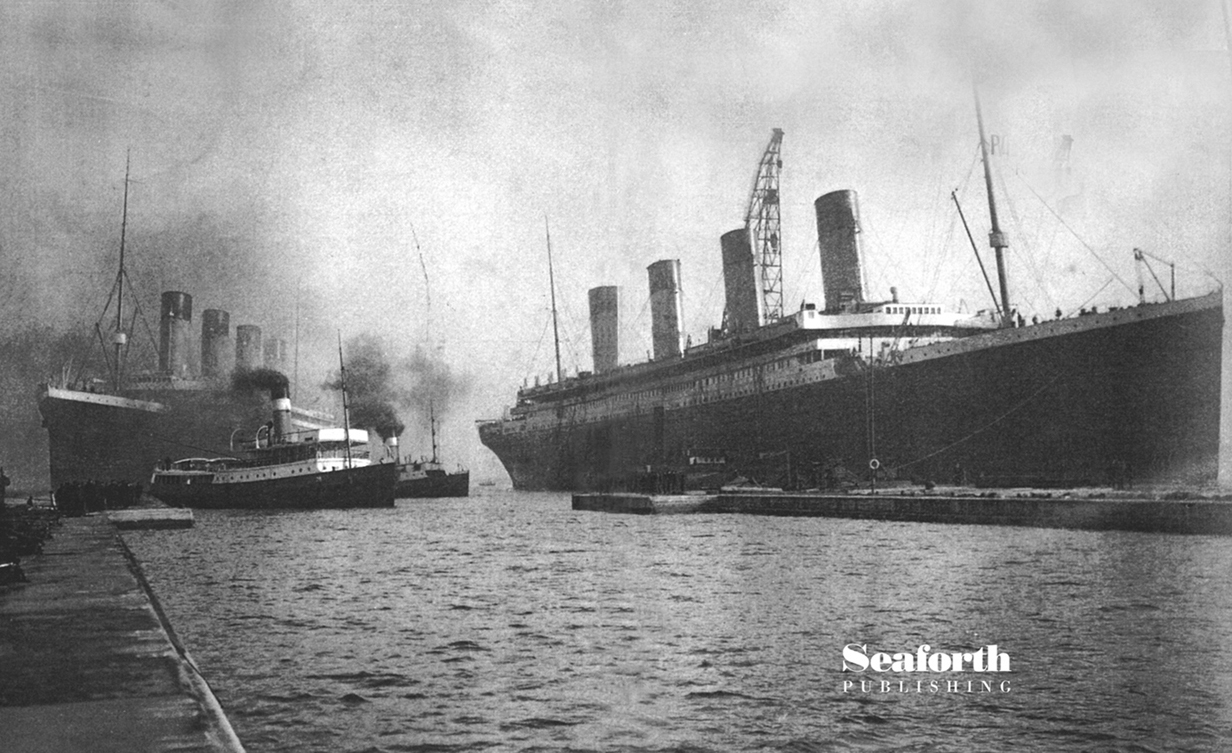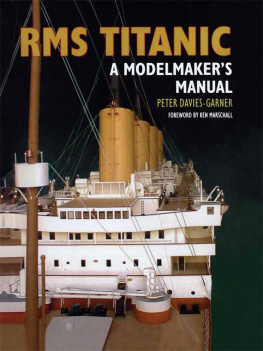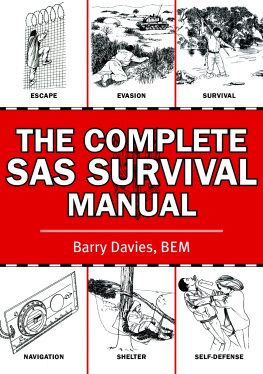Peter Davies-Garner - RMS Titanic: A Modelmakers Manual
Here you can read online Peter Davies-Garner - RMS Titanic: A Modelmakers Manual full text of the book (entire story) in english for free. Download pdf and epub, get meaning, cover and reviews about this ebook. year: 2005, publisher: Pen & Sword Books, genre: Science fiction. Description of the work, (preface) as well as reviews are available. Best literature library LitArk.com created for fans of good reading and offers a wide selection of genres:
Romance novel
Science fiction
Adventure
Detective
Science
History
Home and family
Prose
Art
Politics
Computer
Non-fiction
Religion
Business
Children
Humor
Choose a favorite category and find really read worthwhile books. Enjoy immersion in the world of imagination, feel the emotions of the characters or learn something new for yourself, make an fascinating discovery.
- Book:RMS Titanic: A Modelmakers Manual
- Author:
- Publisher:Pen & Sword Books
- Genre:
- Year:2005
- Rating:5 / 5
- Favourites:Add to favourites
- Your mark:
- 100
- 1
- 2
- 3
- 4
- 5
RMS Titanic: A Modelmakers Manual: summary, description and annotation
We offer to read an annotation, description, summary or preface (depends on what the author of the book "RMS Titanic: A Modelmakers Manual" wrote himself). If you haven't found the necessary information about the book — write in the comments, we will try to find it.
RMS Titanic: A Modelmakers Manual — read online for free the complete book (whole text) full work
Below is the text of the book, divided by pages. System saving the place of the last page read, allows you to conveniently read the book "RMS Titanic: A Modelmakers Manual" online for free, without having to search again every time where you left off. Put a bookmark, and you can go to the page where you finished reading at any time.
Font size:
Interval:
Bookmark:

Side profile. (Scale: 1/600)

The lines plan shows the hull cut into a bow and stern section at the centre frame and the two sections drawn on top of each other. (Scale: 1/300)
RMS TITANIC
RMS TITANIC
A MODEL MAKERS
MANUAL
PETER DAVIES-GARNER
KEN MARSCHALL

Dedication
For all at Harland & Wolff who built and
designed a ship forty-eight times the size of the model
I built, and which in her day was the finest ship in
the world, RMS Titanic.
Copyright Peter Davies-Garner 2005
This edition first published in Great Britain in 2010 by
Seaforth Publishing,
Pen & Sword Books Ltd,
47 Church Street,
Barnsley S70 2AS
www.seaforthpublishing.com
British Library Cataloguing in Publication Data
A catalogue record for this book is available from the British Library
ISBN 978 1 84832 084 0
First published in 2005 by Chatham Publishing
All rights reserved. No part of this publication may be reproduced or transmitted in any
form or by any means, electronic or mechanical, including photocopying, recording, or
any information storage and retrieval system, without prior permission in writing of both
the copyright owner and the above publisher.
The right of Peter Davies-Garner to be identified as the author of this work has been
asserted by him in accordance with the Copyright, Designs and Patents Act 1988.
Printed and bound in China
Frontispiece
Olympic (left) and Titanic (right) together for the last time, March 1912. Titanic is
undergoing yet another alteration to her design: the forward half of her promenade
deck is about to be enclosed. This would be the most immediate difference
between the two sisters. Olympic is being nudged into the drydock to undergo
repairs to one of her propellers.
(Photograph: Terrell Wright)
Contents
B uilding an accurate model of Titanic is an enormous, if not impossible, task. The legendary liner is the most recognised ship in history, yet many of the general public would be surprised to learn that most of Titanics deck spaces were not photographed. Aside from deck plans which do exist, artists and model makers have had to rely on photographs of her nearly identical sister-ship Olympic, and sometimes her less similar sister Britannic, to fill in the many gaps. Britannic was not around very long and never carried a paying, camera-toting passenger, and onboard photographs of her are extremely rare. Olympic ferried passengers across the Atlantic for over two decades, but despite this long and successful career, rivet counters like myself continue to be stymied by the lack of photographic documentation for numerous nooks and crannies on deck.
The discovery of Titanics wreckage was a welcome boon for modelmakers, yielding much new data on the ships structure. The information gap has further narrowed in recent years thanks in large part to several websites devoted to ferreting out these details (see www.Titanicmodel.com). But despite such dedicated research, some areas and mystery fittings remain a frustrating enigma. And there is no one left to ask the people who designed and built these ships are long gone. Nearly a century later, some details of Titanics structure may never be known.
That is why taking on a project like this recreating this famous ocean liner at such a titanic scale is such a daunting task. It has been attempted before, but to accurately replicate something involves intense research, dedication, focus, patience, not to mention the most basic of all requirements paying attention to the photographic record. There are many who simply do not pay attention. As a hopeless perfectionist, I do not have much patience with such modelmakers. Peter Davies-Garner is most emphatically not one of them.
I first learned of Peters Titanic model in April of 2003 while having lunch with Gnter Bbler, president of the Swiss Titanic Society, who was on a two-day layover in Los Angeles. He had brought his good friend Brigitte Saar with him from Germany, specifically to see the large-format 3-D film Ghosts of the Abyss which had just been released here in the US but would not be shown in Europe for nearly eight months. Gnter had seen it already, Brigitte had not. She had actually dived on Titanic a few years earlier and wanted to write a review of the movie for their society journal, Titanic Post. I had participated in the Ghosts project and dived on Titanic myself, so we were eager to experience the film together.
After watching the movie, the three of us walked to a nearby restaurant and enjoyed a meal. We discussed Ghosts, and Brigitte and I shared diving stories. At one point Gnter slid a white envelope over to me, containing several snapshots. He told me there was a guy in Germany who was building a very large model of Titanic and who would be interested in any comments or criticisms I might have.
Oh no, I thought. In my nearly four decades of Titanic study Ive seen many, many models of the ship. None could even remotely be considered perfect, and some, despite flag-waving pronouncements of unsurpassed accuracy, were riddled with errors so obvious that any first-year Titanic student would blush. So when Gnter handed me that envelope, I wondered, what can I say thats nice about this one? Then I pulled out the photographs.
It was instantly apparent that I was looking at something quite different. Unprecedented, in fact. Instead of the dozens of blatant mistakes I routinely saw in other models, I noticed only a few subtle things, things even the most experienced of Titanic researchers might have missed. I tried to act cool, but my jaw must have dropped more than once.
Seeing these photographs was almost like looking at dramatic fresh views of the real ship. Someone, it appeared, had finally, finally done it right. I knew the challenges. I have tried modeling the ship myself and advised on many Titanic model projects for individuals, kit companies, exhibitions and motion pictures. The frustrations were many. Budget or time restrictions invariably prevented a fully satisfying result, or worse, attention simply was not paid to the reference material I provided.
The time and care lavished by Peter on this museum-quality model is evident in every square inch of it. He drafted detailed drawings of most pieces before construction. Every hull plate appears in its accurate length and width, its unique rivet patterns faithful to that particular plate. Little is more important to a models appearance than a smooth and correct sheer (that sag in the hull between the bow and stern), and his is as smooth, graceful and accurate as could possibly be recreated. It is a pure joy to behold.
Peter has excelled in clearly observing what was really there. Instead of plowing through and mass-producing fittings such as ventilators and motors, he noticed the subtle differences between them and included those differences. And he has sensibly applied his research and modeled those mysterious, unknown areas of the ship as they most likely once appeared.
Font size:
Interval:
Bookmark:
Similar books «RMS Titanic: A Modelmakers Manual»
Look at similar books to RMS Titanic: A Modelmakers Manual. We have selected literature similar in name and meaning in the hope of providing readers with more options to find new, interesting, not yet read works.
Discussion, reviews of the book RMS Titanic: A Modelmakers Manual and just readers' own opinions. Leave your comments, write what you think about the work, its meaning or the main characters. Specify what exactly you liked and what you didn't like, and why you think so.












